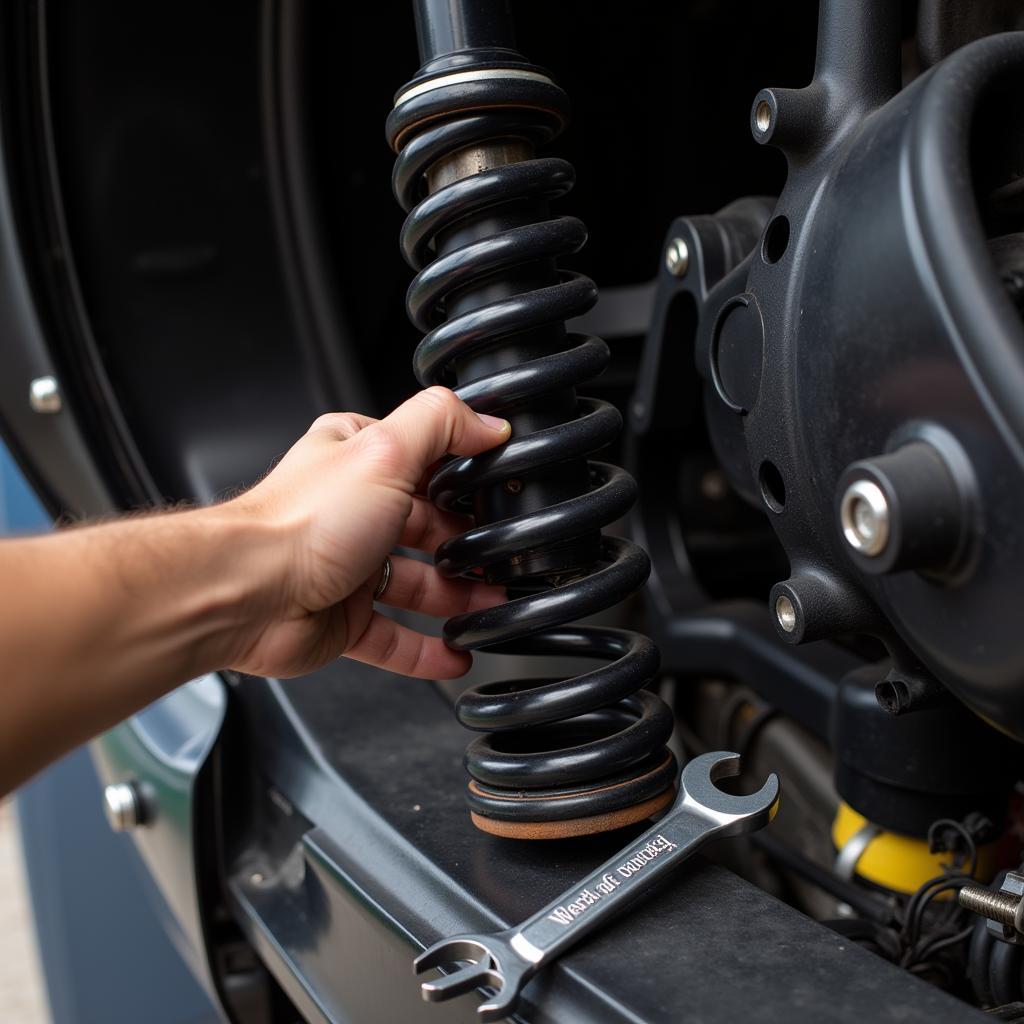A Banked Car Problem can be frustrating and potentially dangerous. This article will cover various causes, diagnostic steps, and solutions for dealing with a car that feels like it’s leaning or tilting, often referred to as “banking.” We’ll explore everything from simple tire pressure checks to more complex suspension issues. After reading this, you’ll be equipped to address this problem effectively.
 Car Tire Pressure Check for Banked Car Issue
Car Tire Pressure Check for Banked Car Issue
Is your car leaning to one side? This unsettling feeling, often described as a “banked car problem,” can stem from several issues, ranging from simple tire pressure discrepancies to more complex suspension or alignment problems. Identifying the root cause is key to a safe and smooth driving experience.
Understanding the Banked Car Feeling
What does it actually mean when your car feels like it’s banking? It’s that sensation that your vehicle is leaning or tilting to one side, especially noticeable when driving straight or turning. This feeling can be accompanied by uneven tire wear, pulling to one side, or a general instability while driving. It’s crucial not to ignore this problem as it can compromise your safety and handling. problems with convertible cars
Why is My Car Leaning to One Side?
A common culprit behind the banked car feeling is uneven tire pressure. Even a small difference in pressure between tires can cause the car to lean towards the side with the lower pressure. Other potential causes include worn or damaged suspension components, improper wheel alignment, a bent frame, or even uneven weight distribution within the vehicle.
 Inspecting Car Suspension for Banked Car Problem
Inspecting Car Suspension for Banked Car Problem
Diagnosing the Banked Car Problem
- Check Tire Pressure: The first and easiest step is to check the tire pressure of all four tires using a reliable gauge. Ensure they are inflated to the manufacturer’s recommended pressure, which can usually be found on a sticker inside the driver’s side door jamb.
- Inspect the Tires: Look for signs of uneven wear, bulges, or damage. Uneven wear can indicate an alignment issue or suspension problem. smart car electric roof problems
- Examine the Suspension: Visually inspect the suspension components, such as shocks, struts, and springs, for any signs of leaks, damage, or wear. A broken spring or a leaking shock absorber can significantly affect the vehicle’s balance.
- Check Wheel Alignment: Improper wheel alignment can cause the car to pull to one side and contribute to a banked feeling. Have a professional check the alignment and adjust it as needed.
How Can I Fix a Banked Car?
Once you’ve identified the cause, addressing the banked car problem can range from simple DIY fixes to more involved repairs. For uneven tire pressure, simply inflate the tires to the correct pressure. However, for issues like suspension or alignment problems, it’s best to seek professional help. smart fortwo car problems,
“Regular maintenance is key to preventing a banked car problem. Consistent tire pressure checks and periodic inspections of your suspension system can help you catch potential issues early on,” advises John Miller, a seasoned automotive technician with over 20 years of experience.
Maintaining Your Car to Prevent Banking
Regular maintenance plays a vital role in preventing a banked car problem. Ensure your tires are rotated and balanced according to the manufacturer’s recommendations. smart car convertible roof problems, Regularly inspect your suspension components for any signs of wear and tear, and address any alignment issues promptly. These preventative measures will contribute to a safer and more enjoyable driving experience. “A well-maintained car not only handles better but also lasts longer,” adds Miller. “Don’t neglect those seemingly small issues, as they can often lead to bigger problems down the road.” switch sd car problems
Addressing a banked car problem is crucial for both safety and driving comfort. By following the diagnostic steps and solutions outlined in this article, you can identify the cause of the issue and take appropriate action. Remember, a little preventative maintenance goes a long way in keeping your car running smoothly and preventing future problems.
In conclusion, understanding and addressing the banked car problem requires a systematic approach. By starting with simple checks like tire pressure and progressing to more complex inspections of the suspension and alignment, you can effectively diagnose and resolve the issue. Remember, a stable and balanced car is a safe car. For further assistance or if you’re unsure about any aspect of diagnosing or repairing your vehicle, feel free to contact us at AutoTipPro. Our team of experts is ready to help.
Contact us at +1 (641) 206-8880 or visit our office at 500 N St Mary’s St, San Antonio, TX 78205, United States.





Leave a Reply